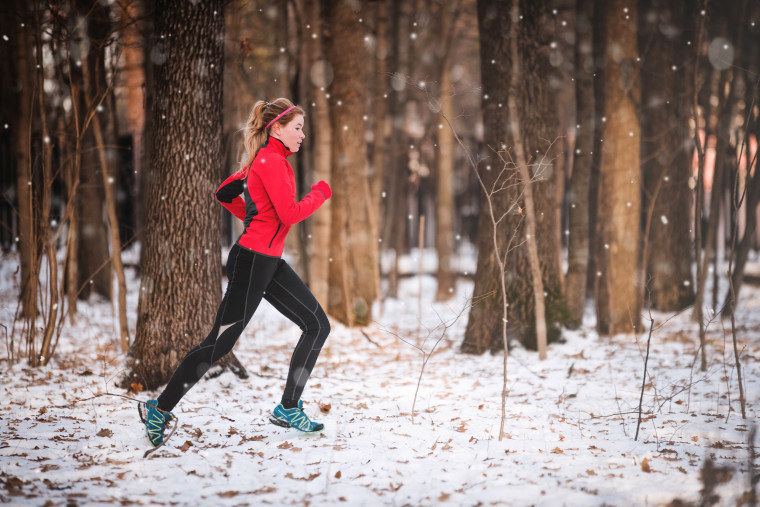Temperatures took a serious tumble in much of the country recently, much to the chagrin of those of us who’d made New Year resolutions to kick off exercise routines that involve the great outdoors.
If working out in the cold feels like more of a slog, that’s because it literally can be. Your muscles have to work harder to complete the same tasks they complete easily in milder weather. In fact, shivering is a reflexive, rapid series of muscle contractions to raise your body temperature. Also, according to the Cooper Heart Institute, the cold constricts your arteries, slowing blood flow to your heart, which requires more oxygen to keep your body warm. During cold weather endurance exercise, Dr. Michael Joyner, an exercise researcher at Mayo Clinic, says your heart rate might be slower than usual because your pace may be slower and your heart doesn't have to pump blood to your skin to stay warm.
If you have a heart condition, a cold weather workout might not be for you. But if you’re heart healthy, there may be an added bonus to a cold weather workout: A well-known study found people who were exposed to cold burned more energy and had less brown fat than those who weren’t.
So, just because it’s literally freezing outside, it doesn’t mean your fitness resolutions should be shelved until the first thaw. We asked Dr. Joyner and and Ariane Hundt, fitness trainer and founder of Brooklyn Bridge Boot Camp, to share their cold weather workout tips for facing the tundra.
Layer up
Both experts agree; before venturing into colder weather to workout, dressing in layers is the key to keeping warm. “You'll be surprised to notice that your body is warm within just a short 5-minute warm-up outside, and you'll want to take off a layer of clothing to continue the workout,” says Hundt. She prefers technical fabrics like polypropylene over cotton or wool, because they are breathable and allow sweat and heat to vent out. “You want to be warm, but not soaking wet from sweating, as that will cool down your body instantly once you slow down your exercise pace,” she says. She also recommends keeping your extremities warm with gloves, a hat and wool socks.
If you’re a runner, Joyner recommends paying attention to the direction of the wind. “When the wind is at your back and you’re dressed for the cold, you can actually heat up a quite a bit. If you turn back into the wind, you can get really cold, really fast,” he says, adding that ice can easily become a deal — and ankle — breaker.
Warm up
Hundt says cold-weather workouts require longer warm-ups than in warmer weather because your joints can feel stiffer. “If you opt to warm-up inside, try dynamic stretches, meaning you move the body through a full range of motion, rather than holding stretches statically,” she recommends. “You can also do a mini-version of the workout you have planned outside, such as squats, push-ups and planks for 5 minutes, before heading out for a park boot camp workout.” Another indoor warm-up she recommends: climb 10 flights of stairs to activate your glutes, hamstrings and quads, engage your core and stretch out your hip flexors.
Stay hydrated
“Hydration during colder temperatures is more important because the cold air is dryer than warm air,” says Hundt. Water is fine if you’re working out for an hour or less but if you go longer and harder, she recommends a carbohydrate drink or electrolyte drink, depending on your level of exertion.
Be mindful of weather
According to the Mayo Clinic, the risk of frostbite is less than 5 percent when the air temperature is above 5 degrees, but it’s the wind chill you have to watch out for — at –18 degrees, frostbite hits exposed skin in 30 minutes or less. Be sure to keep well covered and, if you feel tingling, numbness or burning in your hands and toes, get inside right away to warm up. Joyner, who is from Minnesota, is accustomed to arctic workouts but agrees that super cold temps and wind chills might be good cause to keep your workout inside.
Though it can be super-hard to motivate this time of year, the best part of a cold weather workout is how awesome you’ll feel afterward, says Hundt. Just work up to it. “It doesn't take much to get a good workout in, so if the thought of heading out in the cold is too uncomfortable to bear, commit to only 5 minutes and then see for yourself that working out outdoors in the cold is an experience that makes you not only physically tougher, but also mentally tougher, because you reap nothing but benefits,” she says.
Of course, it might take ten minutes to get all of your gear on first.
GET MORE WORKOUT MOTIVATION
- How to lose weight, according to personal trainers
- 'How I learned to love my body through yoga'
- Why exercising with a crowd supercharges your workout
- What it's like to start your day with a dance party
- The health benefits of losing just 5 percent of your body weight
Want more tips like these? NBC News BETTER is obsessed with finding easier, healthier and smarter ways to live. Sign up for our newsletter and follow us on Facebook, Twitter and Instagram.

